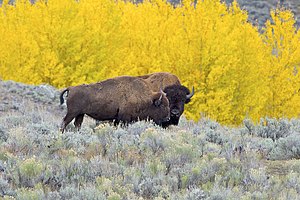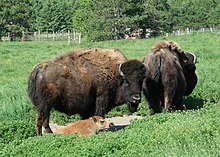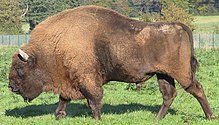Bison bison
The American bison (Bison bison), also called buffalo, and —a word in disuse— Cíbolo, is a species of large artiodactyl mammal of the Bovid family (Bovidae). It inhabited the plains of all of North America, from northern Mexico to the interior of the United States and Canada, in large herds, found from Great Slave Lake to the Chihuahuan Desert, and from eastern Oregon to the Appalachian Mountains. In reference to this species, the term "buffalo", dating from 1635, has more history than the concept "buffalo". bison', recorded 1774; for this reason, in English the first term is used incorrectly.
The American bison has been reintroduced to the northern plains of Mexico, hoping for a speedy recovery of the species where it grazed in previous centuries.
Systematics
Described as Bos bison by Linnaeus in 1758, some authors still call it that way.
Two subspecies have been described: the plains bison (B. b. bison) and wood bison (B. b. athabascae) from Canada.
Features
Bison have dark brown fur in the winter and a lighter, light brown coat in the summer. They can grow up to 1.60 m tall and 3 m long, and weigh from 450 to 1350 kg. Both the male and female have small curved horns, which they use for fighting in mating season and for defense.
Natural history
The American bison is herbivorous; eats grasses and rushes. The bison mate in August and September; he is polygamous Their gestation period lasts between 260 and 280 days, after which a single calf is born and cared for for a year. Bison reach maturity at three years of age, and their average life span is eighteen to twenty-two years.
These animals were the main source of food for the Native Americans of the Great Plains.
The habitat of the American bison is river valleys, prairies, and plains. The most typical habitat is open or semi-open grasslands, as well as sagebrush, semi-arid lands and scrub. Some lightly wooded areas are also historically known to have been home to bison. Bison also graze in mountainous areas where the slopes are not steep. Although not particularly known as high-altitude animals, the Yellowstone Park bison herd is frequently found at elevations above 2,000 meters.
American Bison in Native Culture
Until the 17th century, the American bison roamed the northern territories of the American continent comfortably and abundantly. The buffalo was revered by many of the Native American tribes. In some indigenous nations, the hunting of this animal was accompanied by great respect, admiration for its qualities and gratitude for all the benefits it provided. It is said that, at the moment of the death of the bison, the Amerindian hunter approached to inhale its last breath as a way of spiritually absorbing its virtues. He was known as "giver of life", since all of this being was used. Uses included food, shelter, religious clothing, fuel (the droppings were dried in the sun) and construction materials.
The albino bison or white buffalo is a deity, still present in the XXI century; For example, among the Sioux and Lakota people, spiritual leaders are careful to exclude him from the hunt, as he is a respected, revered, and admired being according to the legend of the "white buffalo woman" of South Dakota.
When the Spanish arrived in America, such was the number of bison or cibolos that the conquistadors found in the great North American prairies, that they called the extensive region bounded by the Rocky Mountains to the west and the Appalachian Mountains to the east « Llanos de Cíbola”, and it was to that region that Francisco Vázquez de Coronado went in search of the mythical Seven Cities of Cíbola. The American bison is the emblem mammal of the US state of Wyoming.
Slaughter of bison and subsequent recovery
The bison population in North American territory around the year 1700 is estimated to be between 30 and 60 million specimens; however, by 1880 this population had already been reduced to just over 1,000 individuals, mainly due to the destruction and fragmentation of pastures, disease, and hunting; American bison hunting precipitated after the arrival of the English in the area. east coast of the continent, since the value of the skins was quite high and it functioned as a catalyst for the slaughter of thousands of animals. When many of the native nations, including the Miami, Smhawnee, and Potawatomi, were displaced, the American bison was hunted to near extinction in the century. XIX, leaving only 750 specimens around 1890. The Bronx Zoo maintained one of the surviving herds, from which the population was restored in Yellowstone National Park and other natural reserves. The current population of American bison is approximately 350,000.
Today, more than 250,000 of the remaining 350,000 bison are raised for human consumption. Its meat has less fat and cholesterol than beef, which has led to the development of beefalo.
In 2009, a project began to reintroduce the American bison in Mexico (a very common animal centuries ago in northern areas of the country); In November of that year, a first herd of 23 bison (twenty females and three males) was released from the Wind Cave National Park (United States) and destined for the El Uno nature reserves in Janos, Chihuahua. On May 13 In 2010, the first calf was born in Chihuahuan territory from those specimens donated by the South Dakota government. By the end of 2018, the bison population in Mexico had grown to 184 individuals. In 2020, 19 Janos individuals were introduced to the El Carmen Nature Reserve, in the state of Coahuila.
Differences from the European bison
Although similar, the European and American bison exhibit a number of physical and behavioral differences. The adult American bison is slightly heavier on average, due to its broader frame, although it has shorter legs. American bison tend to graze more and migrate less than their European relatives. Compared to the muzzle of the American bison, that of the European species is located forward of the forehead when the neck is in a neutral position. The body of the American bison is hairier, although its tail has less hair than that of the European bison. The European bison's horns point forward, making it more adept at fighting.
American bison are easier to domesticate than European bison, and breed more easily with domestic cattle. At the beginning of the s. xxi, most American bison underwent a process of domestication.
Contenido relacionado
Spirochaetaceae
Tetrapetalum
With you




